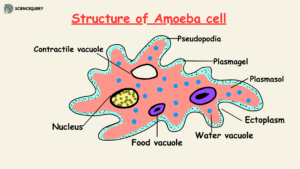
Introduction
Amoeba a simple unicellular organisms or single-cell organisms that can change their shape and move freely as it does not have any cell walls.
Main organelles present in amoeba are

1. Pseudopodia:
- It is also known as the false feet of amoeba.
- The main functions of pseudopodia are locomotion or movement and uptake of food particles.
2. Plasmagel:
The elongated fluid in the amoeba cell is called the plasmagel. It helps in the formation of the pseudopods and thus helps in the movement of the cell. It is more rigid than the inner plasmasol.
The plasmagel is probably alveolar in structure. It contains the same kinds of substances as the plasmasol, but some of the fluid appears to be gelated so as to form alveoli. The plasmalemma probably consists of interwoven protein fibers and a lipoid which fills the interstices (1).
- The plasmagel of amoeba is the outer part of the cytoplasm.
- It is thicker and is gelatinous thus helping in movement.
3. Plasmasol:
It contains various vacuoles like food vacuoles, water vacuoles and contractile vacuoles. It supports the other organelles present in the cell and also helps in maintaining the structure and size of the amoeba cell (1).
- It is the inner emulsion part of the cytoplasm in the amoeba.
- It has suspended vacuoles and granules.
4. Ectoplasm:
The ectoplasm is the outer zone of the cytoplasm of the amoeba. With the formation of ectoplasm, amoeba are capable of movement by making the pseudopodia. The actin and myosin microfilaments of the ectoplasm act just like the vertebrate muscles by using energy generated from the ATP (2).
- Gives elastic support for the cell membrane.
- Contains actin and myosin microfilaments.
5. Water vacuoles:
- They are the type of contractile vacuoles.
6. Food vacuoles:
- These are vacuoles that have digestive functions.
- Hence the ingested matter is slowly broken down by the enzyme like lysosomes.
7. Nucleus:
- It directs the cell activities like reproduction, growth, and other functions.
8. Contractile vacuoles:
AS we all know amoeba lives in fresh water. Hence there is always a pressure to maintain the osmoregulation of the cell. Therefore these amoeba cells have so many vacuoles especially the contractile one. It helps maintain the cell pressure thus keep the amoeba is it shape and size.
- These are osmoregulatory organelles.
- It controls intracellular water and other solute particles.
- Also, regulates the osmotic pressure.
What is a Binary Fission?
Binary fission is an asexual reproduction process. In which a cell or a body divides into two new bodies or two daughter cells
Binary fission in amoeba
- Binary fission in amoeba is a type of asexual reproduction where two identical offspring are produced by only one parent amoeba.
- Binary fission involves the replication of the nucleus first then the cytoplasm and finally splits into two cells.
Advantages of binary fission
- Faster method of reproduction.
- Produces more number of daughter cells in no time.
- A single parent is involved in this process.
- The daughter cells are identical copies of the parent cell.
Disadvantages of binary fission
- Results in the creation of identical offspring.
- Thus, lack of genetic variability.
- Can be detrimental to the species as a whole Advantages of binary fission.
